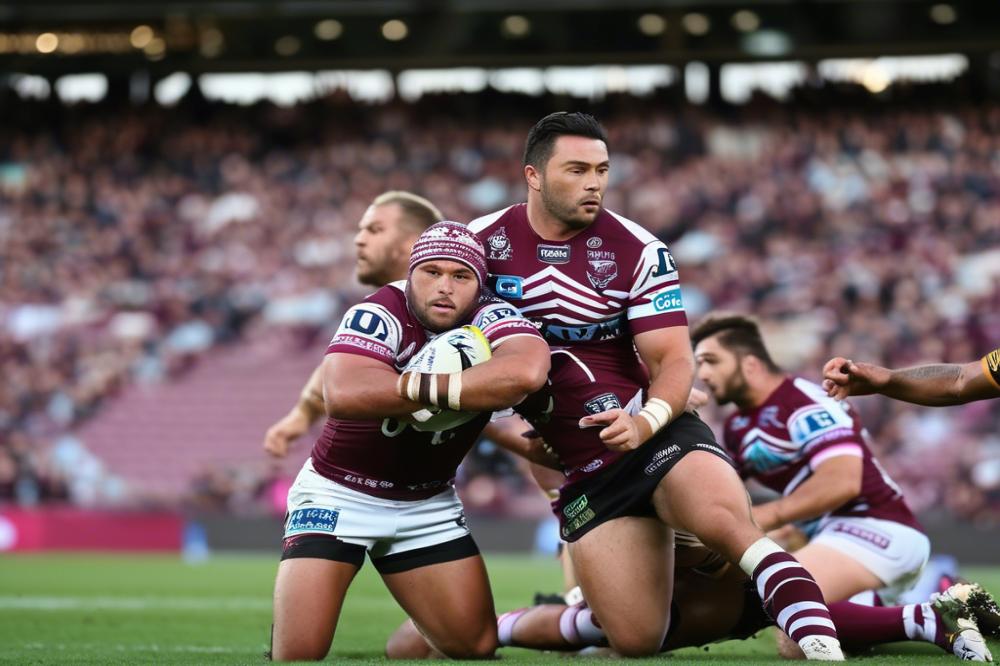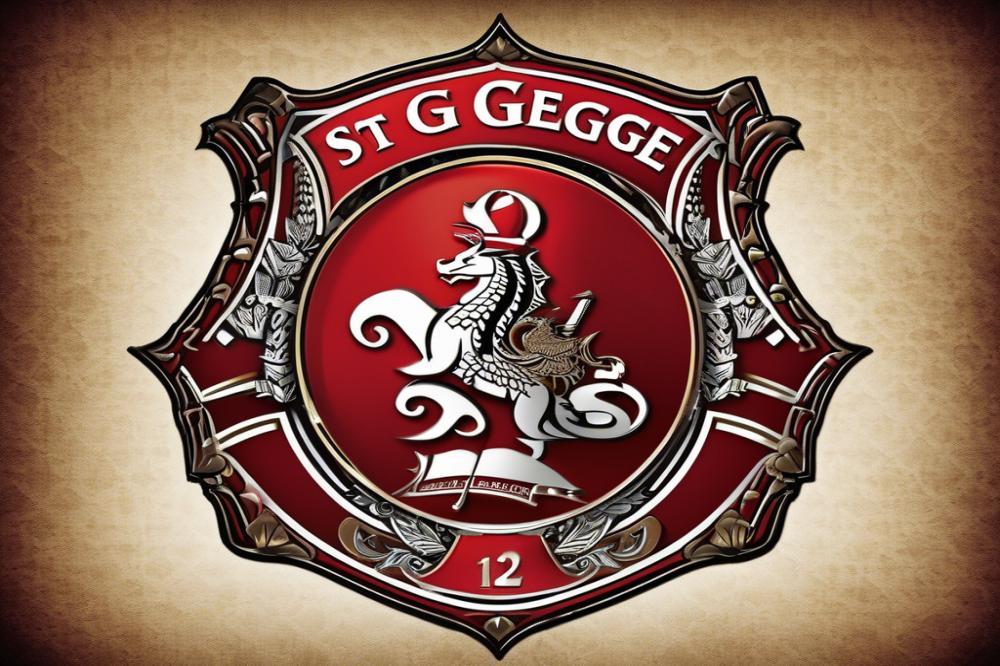The Significance of the Manly Sea Eagles
Within the fast-paced world of rugby league, the Manly Sea Eagles have carved a distinct niche in the NRL. For decades, their unique playing style has been celebrated and scrutinized. Fans and critics alike emphasize the team’s influence on the league. They represent a tradition of excellence and resilience.
Recognized for their tactical evolution, the Sea Eagles have shaped their place in rugby. Not simply relying on current trends, they continually refine their coaching strategies. The drive for innovation propels them forward. This article delves into the evolution of their playing style over time.
The Sea Eagles history is filled with remarkable achievements. What sets them apart is not just the triumphs but also the ways they’ve revolutionized play. From defensive techniques to offensive flair, they’ve done it all. Underpinning this evolution is the emphasis on team dynamics and player development.
The Manly Warringah team stands out due to its commitment to advancement. They’ve mastered the balance between tradition and modernity. Our focus is the transformation of their strategies over the years. This journey illuminates their adaptability and enduring relevance in the NRL.
Origins and Sea Eagles History

The Manly Warringah story began with immense passion for rugby league. This fervor led to the establishment of the team in 1947. Early on, their presence in the NRL showcased a blend of raw talent and strategic gameplay. Starting from Humble beginnings, the club quickly identified the importance of defensive techniques, forming a solid backbone for future successes.
As pioneers in the sport, Manly Warringah exhibited an early commitment to refining coaching strategies. They embraced player development, nurturing skills that contributed to their unique team dynamics. With an emphasis on attacking flair, the early Sea Eagles were not only about strength but also about intelligent play.
The tactical evolution the team underwent was remarkable. It wasn’t just about playing the game; it was about setting themselves apart. Their ability to evolve and adapt became a part of Sea Eagles history, influencing current strategies seen today. Their commitment to advancing as a team laid the groundwork for subsequent triumphs.
Building on its legacy, the Manly Sea Eagles of today hold the same core values. The initial approach, rooted in diverse tactics, still resonates in the modern game. Understanding their origins gives insight into their enduring spirit. Their early days showcase how effective a thoughtful approach can be.
Shifts in Coaching Strategies

Throughout the rich tapestry of Sea Eagles history, various coaching strategies brilliantly altered the landscape of their gameplay. Rugby league demands adaptability, and the coaching minds behind the team have consistently demonstrated this. In the 1970s, Ron Willey introduced a blend of defensive techniques that fortified the team’s performance, making them a formidable opponent in the NRL. His tactics laid the groundwork for a strategic shift focused on robust defense. These strategies also encouraged a shift in player development, emphasizing strength and resilience.
Bob Fulton rose to prominence in the 1980s, bringing a transformative approach with an attacking flair. He harnessed the potential of his players, promoting aggressive plays and risky maneuvers that reflected the evolving nature of the sport. Under Fulton’s guidance, the Sea Eagles embraced a dynamic style that thrilled fans and bewildered opponents. His influence not only changed the tactical evolution of the team but also enhanced the strategic acumen within the league.
The 1990s saw the arrival of Graham Lowe, who placed utmost faith in the importance of team dynamics. He believed unity on the field translated to victories in the league. Lowe’s approach to coaching strategies focused on cohesion, ensuring every player understood their role as part of a collective. This period marked an evolution in teamwork, emphasizing the importance of collaboration and trust.
Manly Warringah’s approach saw another resurgence with Des Hasler in the early 2000s. Hasler redefined the standards by integrating scientific methods and data analytics into training regimes. His unique approach to modern rugby league was innovative, bringing a technical savviness that few had seen before. These methods not only enhanced individual performances but benefited the overall playing style.
Each coaching era contributed to the team’s broader tactical evolution. From defense-focused adaptations to a more unified, data-driven approach, the impact has been profound. The Manly Sea Eagles continue to boast a style that is both historic and progressive, a testament to the astute minds who have navigated decades of change within the sport.
Defensive Techniques

Throughout the history of rugby league, the defensive playbook of the Manly Sea Eagles has undergone significant transformation. Back in the early days of the NRL, their focus was on sheer physical dominance. Defensive walls were formed, designed to intimidate opponents into submission. Tackling was clean but forceful, leaving an impact long after the game. It wasn’t just about stopping attackers; it was a statement.
The 1980s saw a shift. Coaching strategies emphasized agility and speed. Instead of the brute force approach, players mastered positioning. Understanding spatial awareness became crucial. Defensive lines needed to be tight-knit and well-coordinated, which demanded immense teamwork. This era ignited a strategic evolution, requiring brains as much as brawn.
As time marched on, focus shifted once more. The 2000s introduced pressure-based tactics. Teams aimed to minimize space, forcing errors through constant harassment. The Manly Warringah lineup employed a high-press strategy. Attacking flair of rivals was stifled before it could even begin. Opponents felt suffocated under relentless pressure, and the art of intercepting became paramount.
Latest trends in defensive techniques play out on a micro-level. Individual player development is crucial. Each athlete is not just a tackler on the field but a strategist. Players read the game, making split-second decisions. Team dynamics evolve as every participant acts as a cog in the larger machine, constantly adapting to the fluctuating variables of play.
The Sea Eagles history highlights this tactical evolution. Defensive resilience is woven into their identity. The combination of historical methodologies and modern insights shapes their play. The melding of innovation and tradition makes them formidable, keeping them competitive in the ever-challenging landscape of the NRL.
Attacking Flair and Team Dynamics
The Manly Sea Eagles have seen significant transformations in their rugby league strategy, particularly with their attacking prowess. Over decades in the NRL, their tactical evolution has been noteworthy. Initially grounded in strong defense, the team embraced a bold offensive approach that ultimately defined the Sea Eagles history.
A pivotal shift occurred during the mid-2000s. It was a time when coaching strategies emphasized speed and agility. Key players brought innovation onto the field. Breakthrough performances underscored how team dynamics can influence and amplify attacking flair. Manly Warringah turned heads with their ability to create gaps in defensive lines, surprising opposition squads.
Strategic player positioning became a hallmark of their play. Vital to this style was the idea of spatial awareness combined with refined skill. Quarterbacks often acted as playmakers, orchestrating intricate movements that left rivals chasing shadows. The NRL has seen few teams replicate such seamless transitions between defense and attack.
Trust among teammates fostered an environment conducive to this evolution. Players dedicated time to understanding each other’s strengths and weaknesses. When one attacked, another supported, and the understanding was almost instinctual. This reliance created unpredictable gameplay that opponents struggled to comprehend.
The Sea Eagles recognized the need for adaptability. They integrated various defensive techniques, seamlessly blending them with offensive maneuvers. In this dance between enforcing pressure and alleviating it, their relentless pursuit of attacking excellence was evident.
Player development was crucial in supporting this strategy. Young talents received guidance from seasoned veterans. Experience coupled with fresh energy bolstered their version of rugby league, creating a formidable force on the field. This thoughtful amalgamation of experience and youth was vital in their ongoing success.
In conclusion, the evolution of their attacking style, backed by strong team dynamics, has elevated them within the NRL ranks. The Manly Sea Eagles continue to be a testament to how history and deliberate ingenuity shape a legacy in rugby league.
Player Development and Impact
The evolution of the Manly Warringah Sea Eagles’ playing style has been deeply influenced by the development of its players. From the grassroots level to the grand stage of the NRL, each player’s journey enhances the team’s tactical strategy. Young talent nurtured within the club often brings fresh perspectives. This not only enriches team dynamics but also contributes to a broader spectrum of playing methods.
Over the years, several players have notably influenced the Sea Eagles history. Brett Stewart, affectionately known as the “Prince of Brookvale,” transformed the team’s attacking flair with his clever playmaking. His speed and sharp instincts on the field set a benchmark for future fullbacks. Supporting him, players like Jamie Lyon displayed immense versatility. His contributions in both offensive and defensive techniques were pivotal. These athletes enabled a more dynamic approach, propelling the club to greater heights.
Coaching strategies have also evolved alongside player development. With each coach, the tactical evolution of the squad has seen shifts in focus. Some emphasized a strong defensive approach, crafting robust players who could withstand agile opponents. Others concentrated on fluid attacking maneuvers, demanding players to innovate continuously. This has provided the team with a balanced arsenal, aligning perfectly with their goals.
Understanding this symbiotic relationship between player development and playing style underscores the Sea Eagles’ consistent success. The club’s commitment to nurturing talent mirrors its aspirations on the field. This dedication to growth is evident in every game. As new stars rise, they inherit the legacy, adapting and transforming the club’s future. In rugby league, such transformations are vital to staying competitive.
Legacy of Innovation and Adapting
The transformation of the Manly Sea Eagles’ playing style has deeply influenced their standing in rugby league and the NRL. As strategies evolved, the team became synonymous with adaptability. Originally, they relied on sheer physical prowess. Over time, tactics grew more sophisticated, showcasing an understanding of the game’s nuances. This progression attracted a dedicated fan base, enchanted by their gameplay diversity.
Their style is now a blend of strategic defense and inventive offense. This has set them apart on the field. Watching them play, one witnesses a dance of strategy and skill. Each player exhibits a unique flair, reflecting years of evolution. Such refinement didn’t come overnight. It was the result of dedicated adaptation to challenges and changing game dynamics.
The team’s journey is a testament to endurance and innovation. They have not only maintained their presence but have amplified their influence within the NRL. Both seasoned fans and newcomers are drawn to their matches. This magnetism stems from their ability to thrill and surprise. While many teams settle into comfort zones, the Sea Eagles push boundaries. Their incredible adaptability has cemented a lasting legacy in rugby league history.
In essence, the Manly Sea Eagles exemplify that change is not just necessary but beneficial for growth and success in the sport. The evolution of their style reminds us all that staying ahead requires both courage and creativity. As we look to the future, one thing is certain: the Sea Eagles will soar, continually transforming the rugby landscape.



